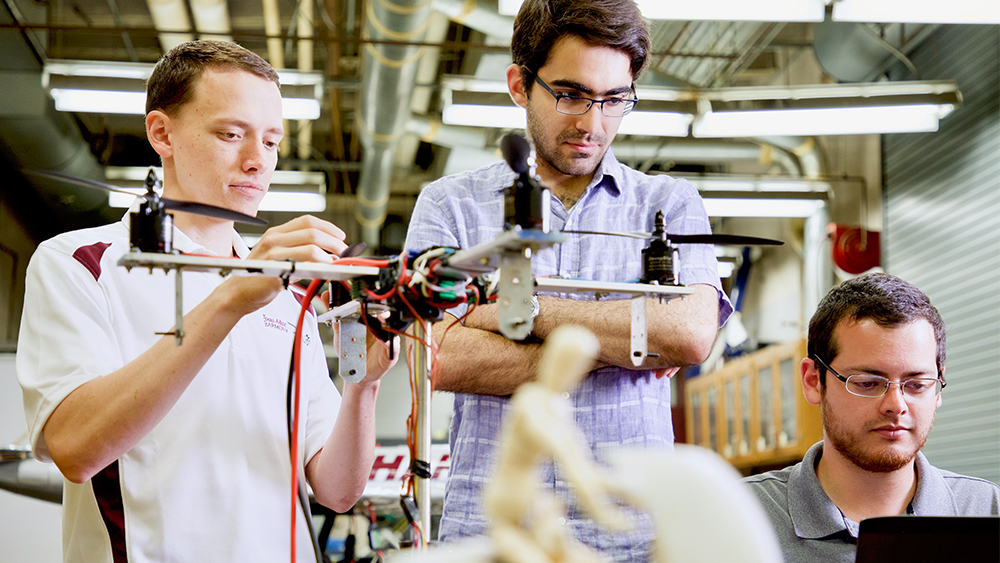
Imagine going out to the garage, jumping into your flying vehicle and heading off to work. Sounds a little like “The Jetsons,” right? Now, Saturday morning cartoons are closer to reality thanks to the GoFly Prize competition sponsored by Boeing to make human flight a reality, and a team from Texas A&M University has accepted the challenge.
GoFly issued a $2 million three-phase challenge in 2017 to inventors to design and build a safe, ultra-quiet and easy-to-fly personal flying vehicle for anyone, anywhere. After winning Phase I for their written report, Team Harmony from Texas A&M stepped up their game and built a beautifully-flying third-scale prototype named Aria to win Phase II and the prize of $50,000. Now the team sets their sights on building a full-scale technology demonstrator for the Phase III final fly-off in 2020.
The team, led by Dr. Moble Benedict, assistant professor in the Department of Aerospace Engineering, along with eight Texas A&M aerospace engineering graduate students and three researchers from NASA and the University of Maryland, is the only United States university team out of the five Phase II winners. To date, more than 600 teams from 110 countries have competed in the GoFly challenge.
Winning both Phases I and II of the GoFly Prize, especially with such fierce competition, has brought lot of excitement and confidence to the team.
"Winning both Phases I and II of the GoFly Prize, especially with such fierce competition, has brought lot of excitement and confidence to the team. We hope to keep this momentum going and win the $1 million grand prize in Phase III," said Benedict.
The goal of the GoFly Prize is to foster the development of a near-vertical-takeoff-and-landing personal flying device, quieter than 87 decibels, and capable of flying 20 miles while carrying a single person. Imagine a vehicle someone could pull out of their garage and take off in to go to work without even blowing the trash can into the street.
“GoFly is unique because we're working on a problem that people have been dreaming of solving for a long time,” said team member Carl Runco. “Everyone wants to fly to work and we are going to make that possible.”
In Phase I, the team spent a semester brainstorming different vehicle configurations before developing a unique “personal air vehicle” concept that simulations showed made less noise at 20 yards than a hair dryer next to your ear. They built a 1/8 scale prototype to demonstrate their vehicle design.
In Phase II, the team spent another semester refining and building a 1/3 scale prototype to successfully verify their full-scale aerodynamic and acoustic predictions through hundreds of hours of lab testing, including wind tunnel tests of their novel rotor system. The team then partnered with FAA-licensed unmanned air systems (UAS) pilot Scott McHarg to conduct more than 50 flight tests of the prototype and demonstrate vertical takeoff followed by steady flight, aborted landings and vertical landings, all required maneuvers for Phase II.
In addition to the required maneuvers and the noise limitations, the final vehicle can be no larger than 8 1/2 feet, capable of carrying a payload of 200 pounds and must travel at a speed of at least 30 knots. The team believes the full-scale rendition of Aria will meet these requirements and win Phase III.
Despite the countless hours the team has put in to developing Aria, they have never lost their positive energy or focus on the end goal. “Although the hours have been long and exhausting, I'm very excited about GoFly,” said team member Farid Saemi. “I would not have enjoyed such a hands-on opportunity to develop a new field of aviation even if I had gone straight to industry as a recent graduate.”
In addition to the long hours, the team still faces many challenges to bring their project to fruition, including raising the necessary funds to finish building the project and getting it commercialized after completion. The Texas A&M Engineering Experiment Station’s Office of Commercialization and Entrepreneurship is helping the team lay the groundwork to commercialize and develop the team’s promising concept into a viable product after the GoFly competition.
Another hurdle will be to get Federal Aviation Administration (FAA) approval to fly the full-size vehicle. The team is responsible for ensuring their device is allowed to fly and is not in conflict with any FAA or other regulations both during flight testing and at the final fly-off. The team is working with McHarg and the Lone Star UAS Center of Excellence at Texas A&M-Corpus Christi to secure flight test authorization from the FAA.
Just as in the first two phases, anyone can compete in Phase III. Teams don’t have to have a win in a previous phase to compete in the final fly-off, but participation will be by invitation only. The fly-off, which will be in early 2020, will consist of two phases: tech inspection and flight demonstration, with scored parameters for size, noise and speed. Team Harmony is ready for these challenges.
The team members from Texas A&M include Benedict, Runco, Saemi, Atanu Halder, David Coleman, Bochan Lee, Hunter Denton and Vishaal Subramanian.